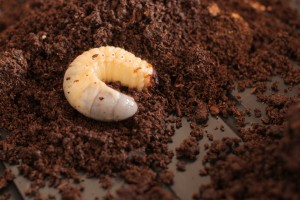What’s better for your lawn?

Dead patch in lawn. Grubs, maybe? Photo: nedwebb, Creative Commons, some rights reserved
The Memorial Day long weekend is often a time to put in the garden, spruce up the yard, and of course, mow the lawn. After the snow from our prolonged winter melted away, many homeowners were disappointed at the condition of their lawn. Areas of dead grass are sometimes, but by no means always, due to heavy feeding by last fall’s grub crop. Grubs, of course, are beetle babies. Not like Ringo Junior, but the larval stage of European and rose chafers, and Japanese, Asiatic-garden, and Oriental beetles.
Unfortunately, you will have to wait until late summer to exact revenge, because short of becoming a skunk-herder and letting your flock dig up all the grubs, absolutely nothing you do to right now will kill the grubs responsible for vandalizing your lawn. Or kill any grubs for that matter. They are done feeding and are in the pupal stage, essentially impervious to poisons.
How do you know if grubs are the problem, or if it’s something else? At this time of year it is hard to tell. One fairly reliable sign of grubs are pockmarks in the yard from crows and skunks grubbing around for snacks. The best time to scout for grubs is in mid-August. Measure out a square-foot patch of lawn and cut the edges with a flat-bottom shovel. The turf will peel back like a carpet, or maybe a sticky carpet, and you’ll be able to look under the hood of your lawn. If there are more than ten grubs in your sample, it may be worth treating the yard.

Japanese beetle grub. Photo: ElHeineken, Creative Commons, some rights reserved
Assuming treatment is in order, you’ll have to pick your poison, literally. A very important fact to consider is that pesticides available at garden centers are not less toxic than ones restricted to licensed applicators. There are other reasons for restrictions, such as the need to understand how to mix different products together depending on site conditions or weather.
The active ingredients in so-called “24-hour” grub treatments are breathtakingly toxic. Take trichlorfon, a popular ingredient in such formulations, for example. Here is an excerpt from a fact sheet from the Extension Toxicology Network, a pesticide information project of Cooperative Extension Offices of Cornell University, Michigan State University, Oregon State University, and University of California at Davis:
“As with all organophosphates, trichlorfon is readily absorbed through the skin. The organophosphate insecticides are cholinesterase inhibitors. They are highly toxic by all routes of exposure. Some organophosphates, including trichlorfon, may cause delayed symptoms beginning 1 to 4 weeks after an exposure which may or may not have produced immediate symptoms. …effects reported include impaired memory and concentration, disorientation, severe depressions, irritability, confusion, headache, speech difficulties, delayed reaction times, nightmares, sleepwalking and drowsiness or insomnia. An influenza-like condition with headache, nausea, weakness, loss of appetite, and malaise has also been reported.”
Maybe it’s just me, but this seems like a rather high price to pay for a greener lawn. Other formulations are not as dangerous as trichlorfon, but caution is still in order. A very popular active ingredient in grub-killers is imidacloprid, one of the neonicitinoids which were just banned throughout Europe because of the risk they pose to bees and other pollinators. I’m not allowed to say our bees are at risk, however. It’s possible they are different from those European bees. Imidacloprid needs to be applied about 30 days before the onslaught of grubs in late July and August.
Names can be deceiving. Chlorantraniliprole is a recent addition to the anti-grub arsenal, and in spite of its intimidating name, it is one of the least toxic chemicals. The issue is that it must be applied about 60 days prior to grubageddon. Then there are worms. Beneficial nematodes to be exact. These microscopic roundworms invade a grub’s body, reproducing inside and finally bursting from the hollow grub carcass. Yum. Nematodes work very well, but are more expensive than most chemicals. Since they are live, they must be direct-shipped and handled with care.
Above all else, the best defense against grubs is to mow high, between 3.5 and 4 inches, no shorter, and to leave the clippings on the lawn. This makes the grass strong enough to withstand some grub feeding without dying off in the spring. After the second year, higher mowing greatly reduces and often eliminates most weeds from the lawn, as well as drastically reduce the need for fertilizer. Try it.
If anyone is successful at skunk farming, please let me know.
Paul Hetzler is a horticulture and natural resources educator with Cornell Cooperative Extension of St. Lawrence County.








I remember reading about mowing higher fifty years ago, and took it to heart. My mother wanted the lawn to look like a green carpet, and I wanted the lawn to look like a manicured hay-field. My wishes won out because I was the lawn boy. Japanese beetles are a lawn creature…if we didn’t insist on having all this stupid grass, we wouldn’t have to think about Japanese beetles.